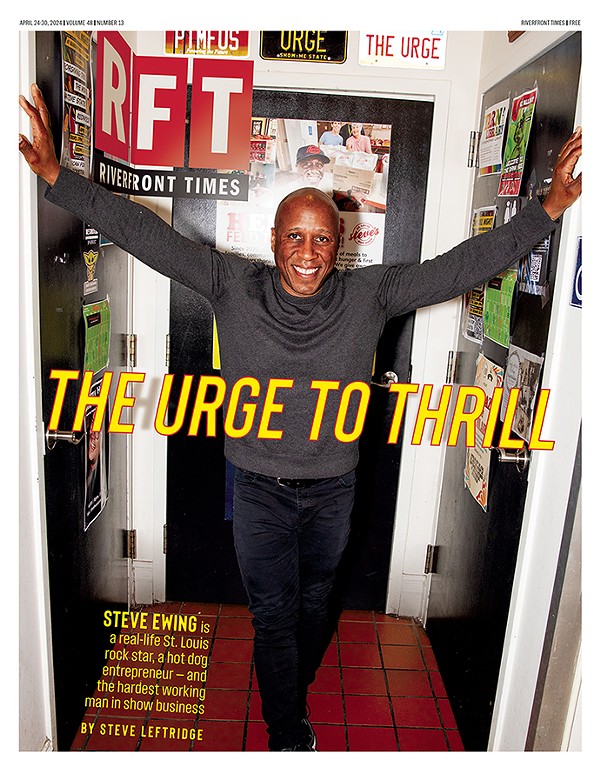Levi has come to Augusta from his home in Washington on the occasion of an exhibition of his and Stang's works, currently on view at Mad Art Gallery in Soulard. In addition, the two 45-year-old artists are preparing for upcoming holiday sales at Mad Art and at Stang's Augusta studio. But the timing for Levi's visit has proven fortuitous for another reason. In late October Stang broke a bone in his left hand while cutting wood near his home. The accident required surgery and the insertion of metal pins. Though Stang always has assistants in his shop, he was glad that Levi was around to lend a hand -- or two.
Their professional relationship dates back to 1985, when Levi joined with Stang and another artist, Dimitri Michaelides, to start Ibex Glass Studio in a building on Tower Grove Avenue. "We were all U. City kids," Stang explains. "Our parents all taught at Wash. U." And all three of them attended Washington University, studying glass in what Stang describes as a "primitive" studio at the time.
But the bulk of their education in glass happened elsewhere. Stang took time off from college to study with the renowned glassblower, Fritz Dreisbach, at Penland School of Crafts in North Carolina. Both Levi and Michaelides studied with Italian master Lino Tagliapietra at Haystack Mountain School of Crafts in Maine in the 1980s. Stang did the same in 1991. After graduating with his BFA from Washington University in 1983, Levi received a scholarship that allowed him to travel to Sweden and apprentice with master glassblower Jan-Erik Ritzman, whom he still considers his mentor.
Forming the Ibex Glass Studio allowed the artists to explore the potential of a distinct stylistic identity. The initial idea was to make glass with clean geometric shapes and bright colors, which other studio artists at the time weren't doing, says Stang. Later the trio decided to venture into designing for factories, making their own molds out of cast iron. "At one point, we were in contact with factories in Italy, talking with Macy's and all the big shots," Stang recalls. "We thought we were well on our way to becoming designers, and we threw all our energy into that direction. One problem with it was that the pieces didn't really look handmade."
"It doesn't pay to be a pioneer," says Levi.
"It doesn't pay to try to compete with the machine," Stang adds.
Still, early sales of Ibex work had gained them tremendous exposure, and their blown-glass pieces were picked up and offered for sale in shops, galleries and museums across the nation. Their vases and bowls even enjoyed cameo roles in films such as Baby Boom (1987) and White Palace (1990) where, the artists joke, their works signify success and yuppiedom.
Ibex Glass Studio was successful, but in 1991 Stang decided to move in his own direction. He split amicably with the Ibex partnership, headed to Augusta, purchased a former gas station and transformed it into Augusta Glass Studio. It's now the base of operation for Stang and his wife, glass artist Kaeko Maehata.
Two years later Levi broke off with Michaelides and, as sole proprietor of the Ibex name, moved the studio to a one-time chicken farm on Whidbey Island in Washington's Puget Sound. Michaelides, now 43, also maintains a glass studio on Whidbey, where he mainly produces large-scale glass sculptures.
Today Stang, Michaelides and Levi are among the most renowned American glass artists, and their works are held in prestigious museum, corporate and private collections the world over. Stang's works are sold locally at Craft Alliance and the Saint Louis Art Museum's shop. Levi's work is available at Xen Gallery in the Central West End.
The works in the show at Mad Art underscore the differences between Stang's and Levi's approach to glass. Stang's works are classical forms -- elegant vases, bowls and flat rondels (large, round plates of glass displayed on forged steel stands). Stang's works are all murrini glass, a technique associated with Venetian glassblowers in which pieces of colored glass rods are arranged on a steel plate, heated, fused and finally blown to reveal a series of concentric mosaic patterns.
Levi's work departs from the traditional vessel forms and explores more abstract territory. Some of his biomorphic vases look like open-mouthed blowfish covered in spiky fins. His larger-scale, organic blown-glass sculptures, like Modern Shape (2004), have a joyful, cartoon-like sensibility. Curtain (2004) is an astounding hanging grid of large, colorful glass discs; it floats happily at the nexus of glassblowing, sculpture and architecture.
Ron Buechele, owner of Mad Art, organized the exhibition and chose to complement the glass work with several gorgeous, luminescent oil paintings by Jaime Gartelos. Buechele is an unabashed fan of Stang and Levi, and by hosting their holiday sale at Mad Art, he's supporting the strong traditions that tie both artists to St. Louis. The glass sales have taken place in the Mad Art space since shortly after the Ibex years, when Hank Griffith and his wife, Linda Fiehler, acquired the former police station with the plan to turn it into a stained-glass shop (Griffith and Fiehler also owned the legendary Mithra stained-glass studio in Soulard, which Fiehler only recently closed). Stang remembers Griffith as a strong supporter of his work and a mentor on business matters. When Griffith died in 1999, Fiehler sold the Art Deco building to Ron Buechele, who also happily inherited the twice-yearly glass sales.
Glassblowing has a strong tradition in the St. Louis region, and it's only getting stronger. Stang recalls that in 1984, when Ibex opened in St. Louis, there were three glassblowing shops in the region, all located at universities -- Southern Illinois University Carbondale, Southern Illinois University Edwardsville and Washington University. Now Stang estimates that there are a dozen glassblowing shops in the area, including private studios and teaching workshops/rental facilities, such as Third Degree Glass at 5200 Delmar Boulevard. In addition, Stang is curating what promises to be a very important glass exhibition at Craft Alliance; the show will open in January 2005 and feature artists from around the world who work in murrini glass.
The continuing enthusiasm for glass is likely the reason that the distinguished Seattle-based Glass Art Society decided to hold its 2006 international conference in St. Louis, which both Levi and Stang see as a real coup for the city.
Back in Augusta, Stang and Levi take a break from their work to talk about their art, their education and their long history together. They quibble a little over the details, but they essentially tell the same story. Their paths may have diverged, but it's clear that the two are never far apart from one another.
Stang takes down a lump of light-blue glass from a shelf and holds it out to Levi.
"What's that?" asks Levi.
"The first piece," answers Stang.
"My first piece?" asks Levi.
"No, my first piece," Stang answers. "But it's probably about the same as your first piece."





